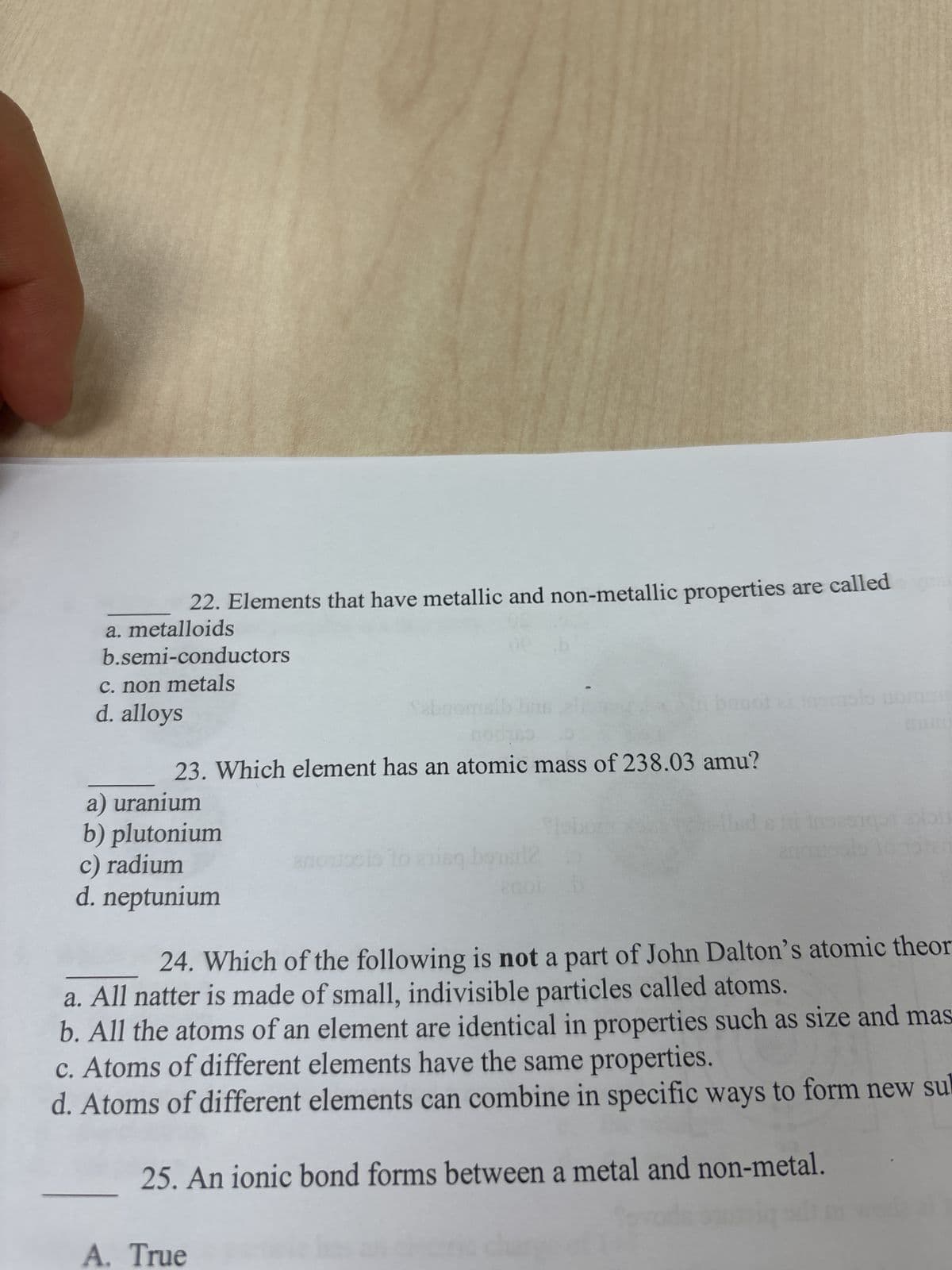22. Elements that have metallic and non-metallic properties are called a. metalloids b.semi-conductors c. non metals d. alloys Sabne buot olo nomme 23. Which element has an atomic mass of 238.03 amu? a) uranium b) plutonium c) radium апо anousis to his bustl d. neptunium 120 24. Which of the following is not a part of John Dalton's atomic theor a. All natter is made of small, indivisible particles called atoms. b. All the atoms of an element are identical in properties such as size and mas c. Atoms of different elements have the same properties. d. Atoms of different elements can combine in specific ways to form new su 25. An ionic bond forms between a metal and non-metal. A. True
22. Elements that have metallic and non-metallic properties are called a. metalloids b.semi-conductors c. non metals d. alloys Sabne buot olo nomme 23. Which element has an atomic mass of 238.03 amu? a) uranium b) plutonium c) radium апо anousis to his bustl d. neptunium 120 24. Which of the following is not a part of John Dalton's atomic theor a. All natter is made of small, indivisible particles called atoms. b. All the atoms of an element are identical in properties such as size and mas c. Atoms of different elements have the same properties. d. Atoms of different elements can combine in specific ways to form new su 25. An ionic bond forms between a metal and non-metal. A. True
Introductory Chemistry: An Active Learning Approach
6th Edition
ISBN:9781305079250
Author:Mark S. Cracolice, Ed Peters
Publisher:Mark S. Cracolice, Ed Peters
Chapter5: Atomic Theory : The Nuclear Model Of The Atom
Section: Chapter Questions
Problem 5.4TC
Related questions
Question
100%

Transcribed Image Text:22. Elements that have metallic and non-metallic properties are called
a. metalloids
b.semi-conductors
c. non metals
d. alloys
Sabne
buot
olo nomme
23. Which element has an atomic mass of 238.03 amu?
a) uranium
b) plutonium
c) radium
апо
anousis to his bustl
d. neptunium
120
24. Which of the following is not a part of John Dalton's atomic theor
a. All natter is made of small, indivisible particles called atoms.
b. All the atoms of an element are identical in properties such as size and mas
c. Atoms of different elements have the same properties.
d. Atoms of different elements can combine in specific ways to form new su
25. An ionic bond forms between a metal and non-metal.
A. True
AI-Generated Solution
Unlock instant AI solutions
Tap the button
to generate a solution
Recommended textbooks for you

Introductory Chemistry: An Active Learning Approa…
Chemistry
ISBN:
9781305079250
Author:
Mark S. Cracolice, Ed Peters
Publisher:
Cengage Learning

Introductory Chemistry: A Foundation
Chemistry
ISBN:
9781337399425
Author:
Steven S. Zumdahl, Donald J. DeCoste
Publisher:
Cengage Learning

Chemistry: An Atoms First Approach
Chemistry
ISBN:
9781305079243
Author:
Steven S. Zumdahl, Susan A. Zumdahl
Publisher:
Cengage Learning

Introductory Chemistry: An Active Learning Approa…
Chemistry
ISBN:
9781305079250
Author:
Mark S. Cracolice, Ed Peters
Publisher:
Cengage Learning

Introductory Chemistry: A Foundation
Chemistry
ISBN:
9781337399425
Author:
Steven S. Zumdahl, Donald J. DeCoste
Publisher:
Cengage Learning

Chemistry: An Atoms First Approach
Chemistry
ISBN:
9781305079243
Author:
Steven S. Zumdahl, Susan A. Zumdahl
Publisher:
Cengage Learning

Chemistry: Principles and Practice
Chemistry
ISBN:
9780534420123
Author:
Daniel L. Reger, Scott R. Goode, David W. Ball, Edward Mercer
Publisher:
Cengage Learning


Chemistry
Chemistry
ISBN:
9781305957404
Author:
Steven S. Zumdahl, Susan A. Zumdahl, Donald J. DeCoste
Publisher:
Cengage Learning